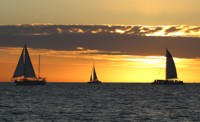Sale on canvas prints! Use code ABCXYZ at checkout for a special discount!
Displaying: 1 - 3 of 3
August 22nd, 2013
Photographer Dick Harper is a barefoot engineer, writer, boat builder, occasional college teacher, and arts council chair.
"The girls say I'm pretty easy; I can be had for most anything with wheels, keels, or terabytes."
Dick splits his time between the Florida Keys and the Vermont farmhouse he shares with a menagerie of cars and tools and boats and a great pile of sawdust from ongoing renovation projects.
CAPTURE THE WORLD ON PAPER™
Writer-photographer Dick Harper has looked at the world with pen and lens for decades. His words paint pictures; his photographs tell stories.
Dick is a newspaper columnist, an engineer, and arts council chair. He is an eclectic and versatile professional with a career that includes publishing and picture taking, teaching and inventing, engineering business solutions and building boats, and racing cars.
A local arts columnist and a regional op-ed writer, Dick's articles and editorials on the arts, business, consumer issues, cars and boats and other grown-up toys, and technology have appeared in national, regional, and local publications. His trade and general interest articles cover manufacturing equipment as well as management for small businesses and for arts organizations. He writes a popular weekly newspaper column and has published technical manuals, textbooks, and short fiction.
He works across northern New England, the Atlantic coast, southern Florida, and the American Southwest. He can be found getting the light right on a bat tower, lying in the grass for a view of brown cows against vibrant foliage, viewing an ancient cactus bloom against biosphere glass, or capturing the vanishing end of a seven mile bridge over clear green water. His photographs have been exhibited in Vermont, New York, Pennsylvania, and Florida and are in private collections in many states and Canada. He has moved exclusively to digital photography and exhibits unretouched original images as well as blending the effects of the digital darkroom.
PROFESSIONAL ORGANIZATIONS AND COMMUNITY SERVICE
Committed to community service, Dick is a founder of and serves as a Director and Chair of the All Arts Council of Franklin County. He served as an Incorporator of the Northwestern Medical Center, and founder and past director of the Missisquoi Health Center. He stood as the long-time elected School Moderator in the Town of Highgate. His other committee work centers on Franklin County volunteer organizations including the Town of Highgate, the Swanton Library, the Franklin-Grand Isle Resource Directory, and the Franklin-Grand Isle United Way. Dick also hosts the televised interview program, Neighbor to Neighbor.
PROFESSIONAL LIFE
Dick brings the juice that makes a product line sing thanks to senior technical management slots with Fortune 500 manufacturers and leadership of a small firm that conceives popular products and initiates the technology leaps for manufacturing them. Not your ordinary inventioneer, he has made breakthroughs in powerboat hulls, material handling equipment, and consumer products.
Visit harperco.net for a look at life in Harper Company.
AVAILABILITY & RATES
Dick Harper can write on assignment or for hire. He offers day rates for location photo assignments and has stock photos of many subjects on hand.
He gives readings, presents lectures on the art of fiction, and can host workshops on the craft of opinion writing. He will speak at panels, meetings, and residencies. He is also available to consult on arts organization as well as growth and marketing for individual artists.
Presentations and workshops range from $500-$1500. Other rates are available upon request.
SOCIAL MEDIA
Here’s Dick's Twitter page (his Twitter username is @northpuffin). Facebook users can find him at facebook.com/dickharper. If you are on Google+ you can find his page at plus.google.com/109821498137481535803. And the official No Puffin Perspective™ is at perspective.northpuffin.com.
"I would like to be remembered as the little kid smart enough to recognize that the emperor was butt naked and ugly to boot."
August 22nd, 2013
If you came here expecting a discussion of the corn used to make fine Kentucky whisky, move along. This is about photography.
A recent Miami Herald article about a West Palm Beach museum includes a shot of photographer 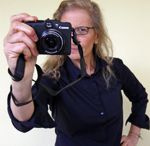 Annie Leibovitz aiming a point-and-shoot camera at the reader. Kind of reminds us that a great photographer can take a magnificent picture with pretty much any box with a hole in one end.
Annie Leibovitz aiming a point-and-shoot camera at the reader. Kind of reminds us that a great photographer can take a magnificent picture with pretty much any box with a hole in one end.
But she still has to print it. That's where I run into difficulty.
If Ms. Leibovitz printed her photos to fit in a standard frame with a pre-cut mat, (most) arts and crafts stores carry frames and mats with openings in only these sizes:
| Frame Size | Mat Opening | Image Size | Aspect Ratio |
| 5" x 7" | 3.5" x 5.5" | 4" x 6" | 1.5 |
| 8" x 10" | 4.5" x 6.5" | 5" x 7" | 1.4 |
| 11" x 14" | 7.5" x 9.5" | 8" x 10" | 1.25 (about 5:4) |
| 16" x 20" | 10.5" x 13.5" | 11" x 14" | 1.27 |
| 20" x 24" | 15.5" x 19.5" | 16" x 20" | 1.25 |
| 24" x 36" | 19.5" x 29.5" | 20" x 30" | 1.5 (exactly 3:2) |
| 30" x 40" | 21.5" x 31.5" | 22" x 32" | 1.45 |
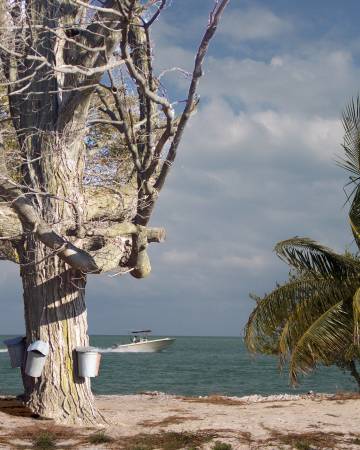
March 3rd, 2013
I bought a new camera body before Christmas. It has me thinking about workflow.
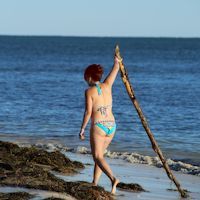
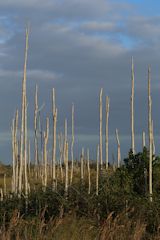 Anyway, I took a few files into the digital darkroom which is where the real magic starts. See, I never owned a chemical-based darkroom so having the classic manipulations -- image brightness, dodging, burning, contrast control, and color balancing -- right here at my fingertips is a miracle. I can accomplish any of those with far greater precision on this screen and see the results as I work, a benefit unavailable in the darkroom and particularly when using an offsite processor.
Anyway, I took a few files into the digital darkroom which is where the real magic starts. See, I never owned a chemical-based darkroom so having the classic manipulations -- image brightness, dodging, burning, contrast control, and color balancing -- right here at my fingertips is a miracle. I can accomplish any of those with far greater precision on this screen and see the results as I work, a benefit unavailable in the darkroom and particularly when using an offsite processor.
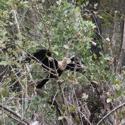
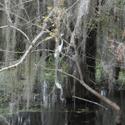 So I also discovered a couple of older images in searching around on the images drive and put them into the gallery as well.
So I also discovered a couple of older images in searching around on the images drive and put them into the gallery as well.
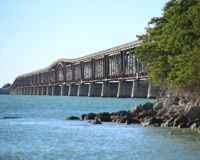
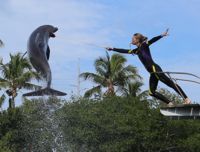 Sculpture Key West was at two of the Civil War forts, Zachary Taylor and at the Garden Club's Martello Tower but I didn't get to West Martello. I liked Thea Lanzisero's Starfish but the mysterious collection of "melting" manhole covers left me kind of cold. I didn't see the art in Richard Brachman's pile of firewood nor in Ursula Clark's pile of grass clippings. On the other hand, Jiwan Noah Singh's geometric pile of lattice and Tebilio Diaz' Flotilla got my attention (you'll see some of those in the gallery eventually) and I took a lot of shots of Sanchez' (rusty) found objects in bloom. I also took a lot of pictures of boats and a lot of pictures of the (not all that good) sunset.
Sculpture Key West was at two of the Civil War forts, Zachary Taylor and at the Garden Club's Martello Tower but I didn't get to West Martello. I liked Thea Lanzisero's Starfish but the mysterious collection of "melting" manhole covers left me kind of cold. I didn't see the art in Richard Brachman's pile of firewood nor in Ursula Clark's pile of grass clippings. On the other hand, Jiwan Noah Singh's geometric pile of lattice and Tebilio Diaz' Flotilla got my attention (you'll see some of those in the gallery eventually) and I took a lot of shots of Sanchez' (rusty) found objects in bloom. I also took a lot of pictures of boats and a lot of pictures of the (not all that good) sunset.
 So far I've winnowed out only about 50 of the 400 or so shots. Worse, now I want to go back for the next full moon to reshoot and to use the longer lens.
So far I've winnowed out only about 50 of the 400 or so shots. Worse, now I want to go back for the next full moon to reshoot and to use the longer lens.
